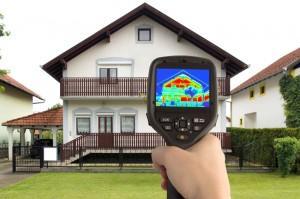Infrared Inspection
 How Does it Work?
How Does it Work?
Thermography — or infrared scanning — is used to detect air leakage, flaws in insulation, and insulation levels in your home’s “building envelope.”
Thermography measures surface temperatures by using infrared video and still cameras, “seeing” where hot and cold air may be entering your home. Capturing images of light that is in the heat spectrum, the video or film records the temperature variations of the building’s “skin,” ranging from white for warm regions to black for cooler areas. The resulting images help the auditor determine whether insulation is needed, or if there are problems with your existing insulation. They also serve as a quality control tool, to ensure that insulation has been installed correctly.
The Benefits of Thermographic Inspection
- Shows the surface heat variations in your home
- Detects heat losses and air leakage in building envelopes
- Allows energy auditors to check the effectiveness of insulation
Technical Break-Down of the Thermographic Inspections
A thermographic inspection is either an interior or exterior survey. The energy auditor decides which method would give the best results under certain weather conditions. Interior scans are more common, because warm air escaping from a building does not always move through the walls in a straight line. Heat loss detected in one area of the outside wall might originate at some other location on the inside of the wall. Also, it is harder to detect temperature differences on the outside surface of the building during windy weather. Because of this difficulty, interior surveys are generally more accurate because they benefit from reduced air movement.
Preparing for a Thermographic Inspection
To prepare for an interior thermal scan, you should take steps to ensure an accurate result:
- Move furniture away from exterior walls
- Removing drapes
- The most accurate thermographic images usually occur when there is a large temperature difference (at least 20°F) between inside and outside air temperatures. In Virginia, scans are usually conducted during warm weather with the air conditioner on.
